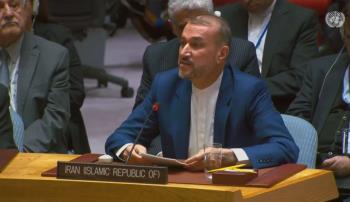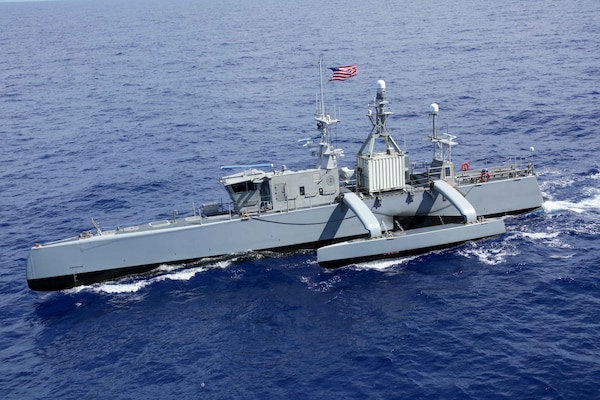Alwaght- Following reports of an attack on an oil tanker, Pacific Zircon, belonging to an Israeli billionaire off Oman coast, the US announced a plan to deploy to the regional waters a fleet of 100 unmanned boats. General Michael Corella, the commander of the Central Command (CENTCOM), said that the deployment is aimed at preventing sea threats in the region.
The CENTCOM issued a statement on November 16, saying the attack demonstrates what it called the destabilizing nature of “Iranian malign activity” in the region.
According to a report by the US Fifth Fleet, though the drones and remotely-guided submarines have developed remarkably, the unmanned boats are new technology that is crucial to the security in the future.
In addition to unmanned vessels, the US is developing a pilot program with its partners in West Asia to defeat "enemy drones," General Corella said, without elaborating. CENTCOM commander called the development of "hostile drones" the biggest technological threat to regional security. These vessels are supposed to cover the waters of southern Iran to the Red Sea and the Indian Ocean.
In September last year, Washington launched ‘Task Force 59’ in Bahrain following some drone attacks allegedly carried out by Iran, which is part of the US Navy's Fifth Fleet to integrate unmanned and remotely-piloted systems and AI.
Capabilities of drone boats
The American drone ships with a wingspan of five meters use solar and wind power to move and can move at an average speed of 5.5 km/h, and for more than a year, conduct long-term operations to collect various data in the sea and oceans without the need to use even renewable energy.
The boats are constantly controlled by a military operator via satellite connection. Their sensors can detect objects at sea and transmit images to the command center. These vessels can collect a wide range of oceanic, navigational and meteorological data as well as strategic information.
These boats enable the US navy to collect data round the clock and improve its data centers to a large extent. If the deployment proves successful, dozens of these vessels will be deployed in different parts of the region, which are much more difficult to monitor with current vessels used by the American navy.
Actually, these drone ships will play the role of new American eyes in the region so that nothing is left unwatched by the country. Accessing extensive information enables Washington to carry out its actions with precise planning.
Countering Iranian naval power
On the strength of its naval power, spying drones, and now unmanned vessels, the US seeks to cover under its intelligence a vast area from Suez Canal to the Indian Ocean to take the appropriate actions to thwart the threats if the need arises.
All the scenarios that the US is devising in the Persian Gulf region are meant to confront Iran, and unmanned vessels are also planned to be part of this project. A few months ago, the Americans claimed that they plan to deploy a fleet of drones in association with their partners in the Persian Gulf in order to deal with the threats posed by Iranian drones.
With regard to the Israeli normalization with the UAE and Bahrain that facilitated extensive presence of the Israelis in the Persian Gulf, the US intends to defend Israeli interests in the Red Sea and Indian Ocean and the AI-powered vessels can undertake part of the mission.
Americans know very well that Iran has massive missile and drones capabilities and is making progress in these fields day by day. The Arab sheikhdoms, which have entrusted their security with the Americans, are extremely worried about the alleged threats from Iran and are trying to use up-to-date American technologies to counter Iran's military power with their petrodollars.
Using reconnaissance radars mounted on the unmanned boats, the CENTCOM aims to collect data on the possible moves against Israeli and Western commercial fleets to thwart the attacks before they are carried out.
Earlier, the Pentagon used its patrol boats in the Persian Gulf to prevent Iranian oil shipments and block Iranian trade to block Iranian circumvention of the illegal Western sanctions. The drone boats are meant to serve the same objective.
The US has already made the preparations for the deployment of 100 unmanned boats. A multinational naval task force led by Bahrain conducted a one-day training drill in the Persian Gulf on October 26, featuring the use of unmanned systems and artificial intelligence alongside seven crewed ships.
“It is so valuable to get these opportunities to really test how our forces from across different nations can work together with the uncrewed systems,” said Royal Bahrain Naval Force Captain Rashed Al-Ameen, commander of Combined Task Force 152, adding: “It helps us better understand how to work with each other to boost regional security.”
Washington is trying to train its Arab allies on these sophisticated systems so that in the future they can use them for data collection and monitoring in the Persian Gulf.
The US navy, on the other hand, is said to be planning to build a low-cost drone ship capable of towing and launching multiple unmanned vessels in the areas of rivalry. The American government has reportedly ordered the military companies to produce this type of ship in the near future, and its construction will probably be completed by 2026. With the American forces unable to easily enter the maritime territory of non-aligned countries, they are trying to launch these ships from afar into the territorial waters of hostile countries and obtain the information they need.
In the past years, the US navy sailors were detained by Islamic Revolutionary Guards Corps (IRGC) navy after intrusion into the Iranian territorial waters. So, Washington eyes to send unmanned drone boats where it needs to watch Iranian movements without the need for sending crews and at a low cost.
Cutting West Asia commitments and focusing on China
The deployment of ships and fighter jets in the region imposed excessive costs on the US in recent decades, and in order to lay down the financial burden, the Americans are trying to reduce these costs as much as possible.
Since President Barack Obama announced a focus on China under “pivot to the East” policy, the US moved to scale down its commitments to West Asia and concentrate on China as what Washington names the biggest threat.
In its national security strategy, the US labels China as the “biggest threat” to its global interests, and tensions between the two countries have surged over the past year.
American strategists argue that Beijing is after challenging Washington's global hegemony and has now broken out of its defensive position and embarked on an offensive one. This gives the Americans a reason to try to free up their force from the Persian Gulf and concentrate on the East to contain China.
China's leader Xi Jinping recently ordered modernization of the armed forces, rendering the American strategists concerned. They know that Chinese military power development along with economic emergence would pull the plug on eight-decade US global hegemony.
Part of the US fleets in the Arab countries is meant to watch sea and ground movements, and if the emerging sophisticated unmanned vessels can do the job perfectly, there would be no need for massive naval and personnel presence in the region, and part of these forces can continue their mission in East Asia.
Still, the US is worried to see Arab monarchies decreasing their trust in Washington, and by announcing the unmanned boats fleet, it hopes to alleviate their security worries and tell them it uses everything at its disposal to protect its Persian Gulf allies.



























